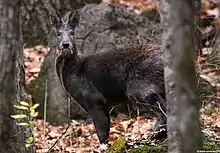| Kashmir musk deer | |
|---|---|
 | |
| Scientific classification | |
| Domain: | Eukaryota |
| Kingdom: | Animalia |
| Phylum: | Chordata |
| Class: | Mammalia |
| Order: | Artiodactyla |
| Family: | Moschidae |
| Genus: | Moschus |
| Species: | M. cupreus |
| Binomial name | |
| Moschus cupreus Grubb, 1982 [1] | |
The Kashmir musk deer (Moschus cupreus) is an endangered species of musk deer native to Afghanistan, India, and Pakistan. Recent studies have shown that the species is also native to western Nepal.[2] This species was originally described as a subspecies to the alpine musk deer, but is now classified as a separate species. The deer stand at 60 cm (24 in) tall, and only males have tusks and they use them during mating season to compete for females.
The Kashmir musk deer, which is one of seven similar species found throughout Asia, is endangered due to habitat loss and also because of poachers hunting the animal for its prized scent glands.[3]
In Afghanistan no musk deer sighting had been scientifically reported from 1948 until 2009. A survey conducted in June 2009 by WCS in the province of Nuristan, Afghanistan found at least three specimens, confirming that the species still persists in this country despite unregulated hunting, extensive deforestation, habitat degradation, and the absence of the rule of law.[4] In summer, musk deer inhabit remote alpine scrub on scattered rock outcrops and in upper fringes of closed coniferous forests at an elevation of 3,000–3,500 m (9,800–11,500 ft) using invariably use steep slopes (≥ 20°). A data-driven geographical model predicted that suitable habitat for musk deer in Afghanistan extends over about 1,300 km2 (500 sq mi) in the contiguous Nuristan (75.5%), Kunar (14.4%) and Laghman Provinces (10.1%). Although relatively vast, the area of habitat potentially available to musk deer in Afghanistan appears to be highly fragmented.[4]
References
- 1 2 3 Timmins, R.J.; Duckworth, J.W. (2015). "Moschus cupreus". IUCN Red List of Threatened Species. 2015: e.T136750A61979453. doi:10.2305/IUCN.UK.2015-2.RLTS.T136750A61979453.en. Retrieved 16 January 2022.
- ↑ Singh, P.B.; Khatiwada, J.R.; Saud, P.; Jiang, Z. (2019). "MtDNA analysis confirms the endangered Kashmir musk deer extends its range to Nepal". Scientific Reports. 9 (1): 4895. doi:10.1038/s41598-019-41167-4. PMC 6426878. PMID 30894581.
- ↑ "Elusive fanged deer spotted for 1st time in 66 years". Archived from the original on 2014-11-07.
- 1 2 Ostrowski, S.; Rahmani, H.; Ali, J.M.; Ali, R.; Zahler, P. (2014). "Musk deer Moschus cupreus persist in the eastern forests of Afghanistan". Oryx. 50 (2): 1–6. doi:10.1017/S0030605314000611.
Notes
- ↑ Only populations of Afghanistan, Bhutan, India, Myanmar, Nepal, and Pakistan. All other populations are included in Appendix II.
